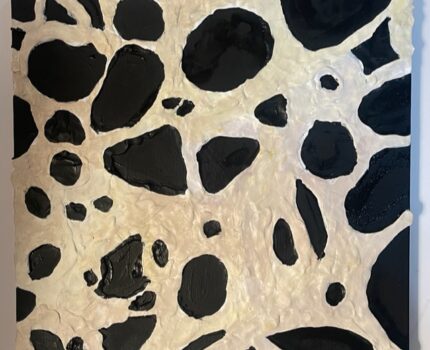Dylan Asplund
Bio F213X Don Larson
STEAM Project
21 November 2023
Post-menopausal Osteoporosis
The piece I created was a mixed media piece of art. I included painting and modeling clay to build my creation. The modeling clay I used was multicolored, so in order for me to have it represent the bone, I needed to paint over it once it dried. I modeled and spread the clay out across the canvas the shapes of a zoomed up bone tissue. Once this was dried it added the dimension I was going for in my piece. After I painted the bone an offwhite color, I filled in the space with black paint. The black paint represents the “holes” in the bone tissue, or where the bone has been resorbed.
Osteoporosis a bone disease that impacts the density of the bones. It is created wehn the rate of bone resorption is greater than the rate of bone remodeling. Osteoporosis results in fragility fractures due to the impairment of microarchitecture and lowered bone mass density (Rachner & Khosla 2011). There are a few factors that make someone at higher risk for osteoporosis however, it is important to understand that anyone could develop it. One of these factors is sex, genetically female people have a much higher risk of osteoporosis. Age is another factor, when humans age so do their bones. As bones age, they are resorbed however, aging also slows the rate of bone remodeling. One way to classify a person having osteoporosis would be if they have a bone mineral density T score of -2.5 or less, another way would be a history of fractures in the hip or spine (Black & Rosen 2016).
Osteoporosis is very common in post menopausal women, this is due to the hormonal changes that occur because pf menopause. During menopause the ovaries shrink, stop producing estrogen and the menstrual periods are eliminated. This impacts the bones of these women because estrogen plays a key role in the formation of new bone.
It is estimated that white women over 50 have a 50% risk of an osteoporotic fracture in their lifetime (Khort & Snead 1995).
There are four types of cells are found within bone tissue: osteoblasts, osteocytes, osteogenic cells, and osteoclasts. Osteocytes maintain bone tissue, Osteoblasts form the bone matrix, Osteoclasts resorb bone, and osteogenic cells are stem cells (Betts et al., 2021, Section 6.3). The cell that is impacted by estrogen is called an osteoblast. Osteoblasts are known for created the bone matrix. When there is a low estrogen level, osteoblast activity is reduced, therefore there are less bone matrix being produced. This results in a faster rate of bone resorption, and a slower rate of bone remodeling.
There are some negative aspects to hormone replacement theory. The cons include an increase in breast cancer, coronary heart disease, and strokes in the estrogen/progestin arm and an excess of strokes in the estrogen-only arm (Papadakis & Hans, 2016). These risks are major and can seemingly outweigh the benefits to bone mass density preservation.
The piece I created shows the bone tissue of someone with osteoporosis, now for the sake of this assignment, the piece I created shows the bone of a post-menopausal woman with osteoporosis.
Works Cited:
Black, D.M., PhD, Rosen, C.J., MD, 2016, Postmenopausal Osteoporosis, The New England Journal of Medicine, https://www.nejm.org/doi/full/10.1056/nejmcp1513724
Papadakis, G., & Hans, D. (2016). The Benefit of Menopausal Hormone Therapy on Bone Density and Microarchitecture Persists After its Withdrawa. The Journal of Clinical Endocrinology & Metabolism, 101(12), 5004-5011. https://doi.org/10.1210/jc.2016-2695
Betts, J. G., Young, K. A., Wise, J. A., Johnson, E., Poe, B., Kruse, D. H., Korol, O., Johnson, J. E., Womble, M., & DeSaix, P. (2021). Anatomy and Physiology 2e. OpenStax. https://openstax.org/books/anatomy-and-physiology-2e/pages/1-introduction
Kohrt, W. M., PhD, Snead, D. B., Slatopolsky, E., & Birge, S. J., Jr (1995). Additive effects of weight-bearing exercise and estrogen on bone mineral density in older women. The American Society for Bone and Mineral Research, 176-181. https://doi.org/10.4103/2230-8229.142972Rancher, T. D., MD, & Khosla, S., Professor (2011). Osteoporosis: Now and the Future. The Lancet, 377(9773), 1276-1287. https://doi.org/12 November 2023


Dylan chose post menopausal osteoporosis as the subject of his STEAM project. The clay creation shows the bone matrix being less dense and more porous looking due to the inactivity of the osteoblasts. Anyone is prone to having osteoporosis, although based on your sex and age you may be predisposed to it more than the person next to you. Estrogen plays an important role in osteoporosis which is why females are more prone to showing signs than males. While there is hormone replacement therapy to aid females in the decrease of estrogen post menopause, there are risks associated with this therapy where the benefits must be weighed against the costs.